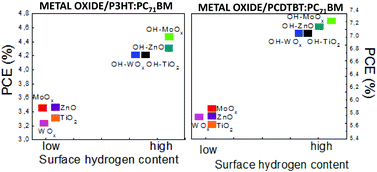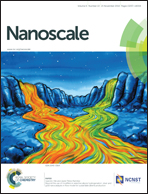The effect of surface hydrogenation of metal oxides on the nanomorphology and the charge generation efficiency of polymer blend solar cells†
Abstract
In this work, the effect of surface hydrogenation of different metal oxides, in particular molybdenum and tungsten oxides widely used to enhance hole extraction and zinc and titanium oxides widely used to enhance electron extraction, on the nanomorphology and the charge generation efficiency of polymer blend solar cells is investigated. It was found that photoactive layers based on blends using different polymers, in particular poly(3-hexythiophene) (P3HT) and poly[(9-(1-octylnonyl)-9H-carbazole-2,7-diyl)-2,5-thiophenediyl-2,1,3-benzothiadiazole-4,7-diyl-2,5-thiophenediyl] (PCDTBT), which normally differ in both morphology and electronic structure, benefited, for both polymers, from deposition on metal oxides with high surface hydrogen content, in the sense that they exhibited improved crystallinity/order as revealed from X-ray diffraction, UV-vis absorption and elipsometric measurements. As a result, increased charge generation efficiencies and reduced recombination losses were measured in solar cells using metal oxides with highly hydrogenated surfaces at bottom electrodes and based on blends of either P3HT or PCDTBT, with a fullerene acceptor, as was verified by transient photocurrent measurements. The power conversion efficiency (PCE) of those cells reached values of 4.5% and 7.2%, respectively, an increase of about 30% compared with the cells using metal oxides with low surface hydrogen content.


 Please wait while we load your content...
Please wait while we load your content...